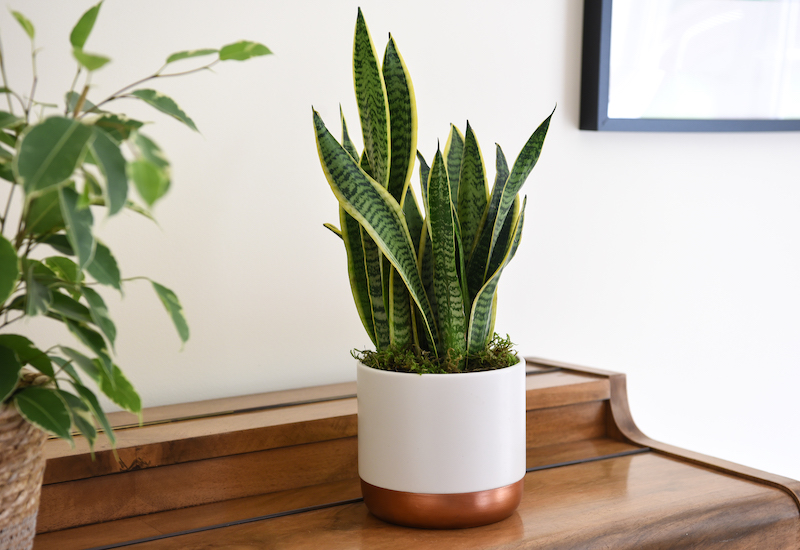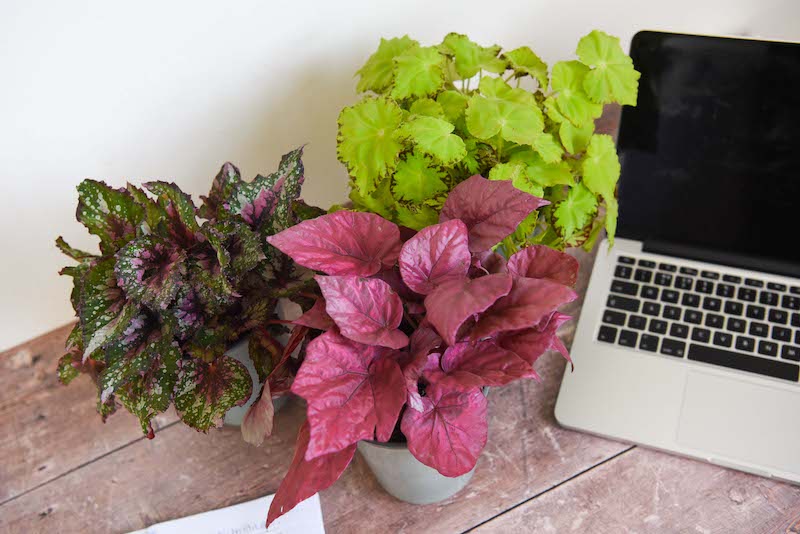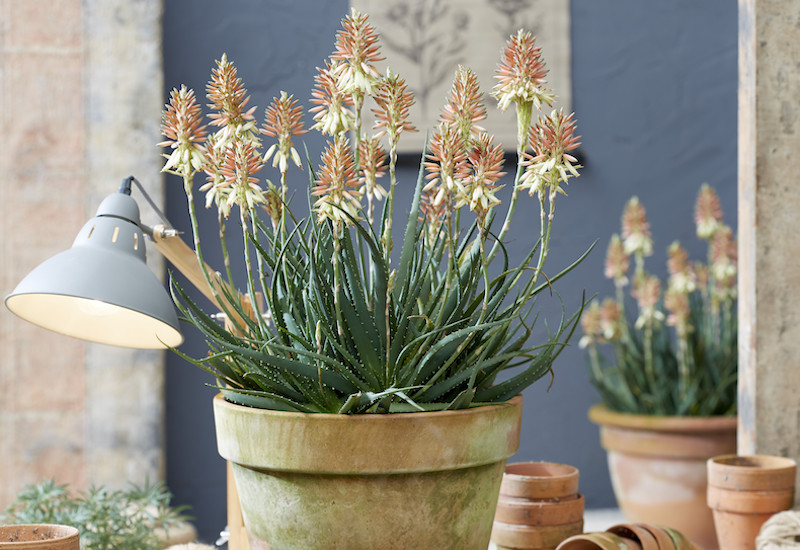If you’d like to grow healthy, thriving houseplants, here’s where you’ll find all the helpful advice you need. Here are some of our favourite blogs, YouTube videos and Insta posts offering expert tips on houseplant care. These social media savvy growers really know their stuff and can’t wait to share their knowledge and enthusiasm with you…
Contents
- Best advice on which houseplant variety to choose
- Best advice on light and location for houseplants
- Best advice on feeding and watering houseplants
- Best advice on repotting and pruning houseplants
Best advice on which houseplant variety to choose

Image: Sansevieria Trifasciata Var. Laurentii (Mother in Law’s Tongue) from Suttons
Indoor palms bring more than scale and structure to your indoor planting scheme, says John Moore at Pyracantha. One of his top 10 must-have air purifying plants, he writes that the golden-caned Areca Lutescens (palm) actually helps to remove formaldehyde and xylene from the air and, according to NASA, is one of the best natural air quality enhancers money can buy.
“Living and working alongside plants makes us happy,” says Sue Jeffries of SJ Garden Advice. But in order for your houseplants to be happy too, you do need to choose the right plants for the right spaces. Luckily she’s on hand to offer some excellent advice. Shady corner? Sue says an indoor begonia will love it there while aloe vera and other succulents thrive in sunny rooms and on windowsills.
If you’re new to growing houseplants, you’ll definitely need to check out Claire Lowrie’s YouTube channel, The Jungle Haven. She specialises in indoor plants that are easy to grow and difficult to kill. Among her favourite plants for beginners are, Mother In Law’s Tongue and the equally strangely named – and hardy and adaptable – Monstera Deliciosa or ‘Swiss Cheese Plant’
For those on the lookout for some of the rarer houseplants which are also low-maintenance and suitable for relative novices to grow, YouTuber Hannah McFarlane at Tropical Plant Addict suggests some great options. From Syngonium Pink Splash to Anthurium Forgetii, her collection of exotics is well worth a view. She says if you’re looking for a starter plant that’s almost impossible to kill, Snake Plant (Mother In Law’s Tongue) is the way to go.
Best advice on light and location for houseplants

Image: Branded Garden Products
“Think of a plant as a human being, and light as being food,“ says Caroline Cocker of Planet House Plant. “No human can survive without food. However, there’s a plethora of factors that determine how much food each individual requires.” Wise advice for anyone growing plants indoors or out. If you’re looking for a plant that survives even the darkest of corners, Caroline recommends Zamioculcas zamiifolia (ZZ) which she says is “the closest you’ll get to a plastic plant.”
If you’re growing in low light, it’s still better than no light, says Tom Knight of Our House Plants: “Be realistic…house plants grown in less than optimal conditions will grow very slowly (if at all). You will never have a regularly blooming Peace Lily if it’s hidden away in a dank corner.” If light is limited in your home, one thing you can do, Tom says, is to rotate your plants, giving each a holiday in a brighter spot.
One sign your plants aren’t happy in the shade is that they begin to lean towards the available light. Highly knowledgeable gardening writer and podcaster Jane Perrone says you should also look out for plants which become spindly or whose leaves begin to yellow. She advises that you should take care not to overwater your plants, especially if they’re in shadow most of the time, or the roots may rot.
Shady spaces? Try a heartleaf philodendron, says indoor plant collector, Abi Bloom. Hers has never been in the light and has flourished for years. In fact her plant is too big to bring to the camera, so she shows one of the many cuttings she’s taken. This one already looks glossy and luxuriant despite not yet having been planted into compost. As a low light loving plant, this is a must.
While it’s true that many plants love plenty of brightness, too much concentrated light burns leaves and withers stems. If that sounds familiar, Caroline Cocker from Planet Houseplant recommends growing succulents. She also suggests Monstera deliciosa which, with its giant leaves, brings a real wow factor to a sunny spot, but will scorch if left in direct sun for too long.
West light is the best light for houseplants, says Dr Laura Jenkins at Houseplant House. In her brilliant post she explains the key attributes of light from all points of the compass. She adds that regardless of the orientation of your rooms to the light, rotating your plants regularly is the best way to keep growth balanced, especially during the winter when weaker light levels can make plants begin to lean unattractively.
As houseplants, indoor begonias have everything going for them, says Geoff of YouTube channel, Tropical Plants at 53 Degrees. In this short video, Geoff shows off his begonia ‘Curly Fireflush’. We think you’ll agree, it’s a beauty and, for those who associate begonias with municipal bedding plants, it’s sure to make you reconsider the virtues of this wonderful plant.
Typically a tricky room to furnish with houseplants, your bathroom is the focus of an excellent blog post courtesy of plant expert, Chanel De Kock at The Joy of Plants. “Choosing the right plant to suit the environment is essential,” says Chanel, whose plant recommendations for the bathroom include ivy and ferns, a carnivorous plant or two to keep creepy crawlies under control and orchids which love warm, humid conditions.
Best advice on feeding and watering houseplants

Image: Monstera deliciosa Swiss Cheese Plant from Suttons
“Without watering a houseplant will die,” says Tom Knight at Our Houseplants. While this fundamental principle might seem obvious, what’s less well understood is just how important watering is for indoor plants. Tom says, “there isn’t a hard and fast rule to follow, it’s a simple case of observing your plant, and interacting with it.” Learn how to get it right by reading Tom’s excellent guide to watering houseplants.
If you’re new to houseplants, Claire of The Jungle Haven says that the best piece of advice she would offer you is that underwatering indoor plants is always better than overwatering. Too much water, she says, is one of the biggest plant killers there is. For more excellent info on growing houseplants for beginners, do watch the rest of her video.
Give your houseplants a health check this winter with a little help from expert plant blogger Jane Perrone. She says: “If you can, take plants out of their pots and check the roots are firm, not smelly or mushy. If there are lots of roots on the surface of the soil, this usually means that you are watering little and often, which isn’t great for plants as it exacerbates plant stress.”
If you’re growing Monstera deliciosa, be sure to pay close attention to watering. Caroline Cocker of Planet Houseplant recommends about once per week during the summer, but dial that right down during the winter. She says: “In winter I wait until my Monstera is pretty dry before I water it. I’d say it probably goes a good month in between waterings, but again check the soil.”
Should you realise with dismay that you’ve accidentally overwatered your Monstera deliciosa, all is not lost. Posting on Insta, Andi @little_home_jungle says: “A year ago my variegated monstera cutting nearly died from root rot. I decided I’d try and save it by cutting it right back to just the node and placed the tiny wet stick in sphagnum moss. It worked.”
Over at @stephwilsonspace, Steph shows us that even a cactus with root rot can be salvageable. Having adopted one in a pot without drainage, she had to take drastic action to save it, drying it until a callus formed over the stump before repotting in the correct grit/peat-free potting mix. And this time in a container with holes!
Liquid Baby Bio is Tropical Plant Addict, Hannah McFarlane’s go-to plant feed. If feeding houseplants during the winter, she recommends diluting your feed a little more than it says on the label and to mix it with room temperature filtered water. Want proof this works? See how a good feed perked up Hannah’s palm which had been surviving but not thriving.
Best advice on repotting and pruning houseplants

Image: Dionaea Muscipula (Venus Fly Trap) from Suttons
Not only does repotting your houseplants enable the plant to generate fresh, healthy growth, it also means you’ll have to water less. In his unmissable guide to repotting houseplants, Tom Knight at Our House Plants explains the roots of pot-bound plants completely fill their containers meaning there’s little soil to retain moisture. Repot into a bigger container and there’s more space for water retention.
If you’re about to begin repotting your houseplants for the first time, a visit to Houseplant House is a must. There, Dr Laura Jenkins gives you a run down of the whole process beginning with the essentials. She says: “If I was to suggest three purchases as a ‘starter kit’ I would recommend a bag of houseplant compost, orchid bark & some perlite. You can build up some of the other items over time as you need them.”
Do you own a peace lily? If you’d like to know how to spot when yours needs repotting, do visit John Moore’s blog, Pyracantha. In his post on repotting peace lilies, he says, “The first signs you will notice that it needs repotting is that it will start to wilt more frequently between watering as the soil is unable to retain much moisture when watered.” Check out the post for more info.
For those about to repot a Monstera deliciosa, this post from the wonderful blog, GreenGrow is required reading. In it, this green-fingered grower provides a step-by-step approach with lots of photos for illustration. If, like her, you’re transplanting into a self-watering pot, you might try adding some Orchid planting mix to the compost to help it drain more freely.
If you’re repotting an areca palm or similarly big, bushy houseplant, keep its fronds under control and avoid causing the plant unnecessary damage by cable tying them together before you begin. That’s how YouTube’s Arif Khan approaches the job. Check out his channel, Khanz Plantz as he shows you the whole repotting process from start to finish
Of course, you don’t have to repot in soil at all. Why not create an authentic desert display by planting succulents in a terrarium? Creating an attractive feature for any sunny room is within reach as Sue Jeffries of SJ Garden Advice demonstrates. She says succulents are “slow growing and should be happy in their terrarium for a few years, but when they out-grow the container you can take them out and replant them into a larger glass or ceramic container.”
With all this great advice at your fingertips, the wonderful world of houseplants is there for the planting. What are your top tips for growing indoor plants? We’d love to hear from you. Just join in the conversation on Facebook or Twitter.
Lead image: Aloe – Safari Sunrise/ Copyright: Fairweathers / Visions BV, Netherlands
Last Updated on December 10, 2025 by Suttons Horticultural Team






This article is an absolute treasure trove of expert advice on growing houseplants!
It’s like having a seasoned gardener whispering their green secrets directly into our ears. I couldn’t agree more with the emphasis on choosing the right plant for your space. Understanding your home’s lighting conditions is key to matching the perfect plant partner.